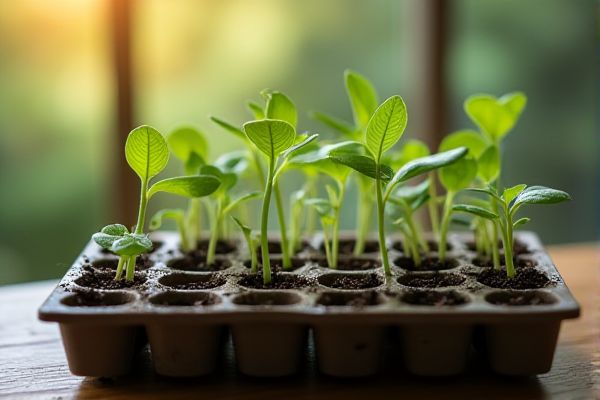
Seed trays provide a larger growing area and are ideal for starting multiple seeds in one container, while cell packs offer individual compartments that promote healthier root development and easier transplanting. Explore the rest of the article to discover which option best suits your gardening needs and enhances your seed-starting success.
Table of Comparison
| Feature | Seed Tray | Cell Pack |
|---|---|---|
| Structure | Single large flat tray | Multiple small individual cells |
| Seed Germination | Good for mass sowing | Ideal for individual seed handling |
| Root Development | Roots may tangle without cells | Prevents root disturbance and tangling |
| Transplanting Ease | Requires careful root separation | Easy to transplant without damage |
| Space Efficiency | Less efficient space usage | Optimizes space with compact cells |
| Durability | Typically plastic, reusable | Plastic or biodegradable options available |
| Cost | Generally lower cost | Higher cost due to cell divisions |
Introduction to Seed Trays and Cell Packs
Seed trays and cell packs are essential tools for efficient seed starting and plant propagation, designed to optimize germination rates and root development. Seed trays typically feature open flats with varying depths to accommodate different seed sizes and growth stages, allowing for easy watering and transplanting. Cell packs consist of multiple individual cells or compartments, promoting healthier root systems by minimizing root disturbance during transplant and enhancing seedling survival.
Understanding Seed Trays: Features and Uses
Seed trays offer a versatile and efficient option for starting a variety of seeds, featuring multiple small compartments that promote healthy root development and easy transplanting. These trays are typically made from durable plastic or biodegradable materials, ensuring proper drainage and aeration essential for optimal seed germination. Using your seed tray effectively can enhance seedling growth and improve overall plant success in nursery or garden settings.
What Are Cell Packs? Advantages and Applications
Cell packs are modular seed-starting containers with individual cells designed to promote healthy root development and easy transplanting. They offer advantages such as space efficiency, improved drainage, and reduced root disturbance, making them ideal for growing seedlings in commercial nurseries or home gardens. Your seedlings will benefit from consistent moisture control and rapid growth, enhancing overall planting success.
Material Differences: Durability and Sustainability
Seed trays are typically made from durable plastic or biodegradable materials that offer long-lasting use and eco-friendly options, while cell packs are often constructed from lightweight plastic or molded pulp, balancing durability with sustainability. The sturdy plastic seed trays provide reusability for multiple growing seasons, whereas biodegradable cell packs decompose naturally, reducing environmental impact. Choosing between the two depends on your preference for durable reusability or sustainable compostability in your gardening practices.
Space Efficiency: Maximizing Growing Area
Seed trays offer space efficiency by providing a large, continuous growing surface ideal for dense sowing, maximizing your growing area in limited spaces. Cell packs, with their segmented design, optimize root development while allowing for better airflow and drainage in each cell, although they may occupy slightly more space per seedling. Choosing between seed trays and cell packs depends on balancing space constraints with the need for individual plant health and ease of transplanting.
Watering and Drainage: Which System Performs Better?
Seed trays with larger cells generally offer superior drainage compared to cell packs because their design includes more spacious cavities that prevent waterlogging by allowing excess water to drain easily. Cell packs, while efficient for seedling organization, often retain more moisture, increasing the risk of overwatering and root rot if not monitored closely. Effective watering in seed trays supports healthier root development by balancing moisture retention with proper drainage, whereas cell packs require careful watering management to avoid water accumulation.
Transplant Shock: Ease of Seedling Removal
Seed trays often cause less transplant shock due to their larger planting areas, which make seedling removal easier and reduce root disturbance. In contrast, cell packs, with individual compartments, can lead to more root damage if seedlings are not carefully extracted, increasing the risk of transplant shock. Proper handling techniques are essential for minimizing stress regardless of the container type used.
Cost Comparison: Initial Investment and Longevity
Seed trays typically demand a lower initial investment due to their simpler design and fewer materials, making them cost-effective for short-term use. Cell packs, although often more expensive upfront, offer greater durability and longevity, reducing the frequency of replacements and overall costs over multiple growing cycles. Evaluating the balance between initial expenditure and long-term use is crucial for optimizing budget efficiency in seed propagation.
Suitable Plant Types for Seed Trays vs Cell Packs
Seed trays are ideal for large-seeded vegetables like squash, pumpkins, and cucumbers that require ample space for root development, while cell packs are better suited for small-seeded plants such as lettuce, herbs, and flowers that benefit from individual cells to prevent root disturbance. Seed trays provide a broad, open environment promoting extensive root growth, making them perfect for transplants needing robust root systems. Cell packs enhance disease control and ease of handling by isolating seedlings, thus supporting delicate or slow-growing species requiring precise moisture and nutrient management.
Choosing the Best Option for Your Garden
Seed trays offer a larger surface area for starting multiple seeds, making them ideal for gardeners who need to sow a variety of plants quickly. Cell packs provide individual compartments that promote stronger root development and reduce transplant shock, which benefits seedlings needing more care. Your choice depends on your garden's space, plant types, and desired seedling quality.
 homyna.com
homyna.com